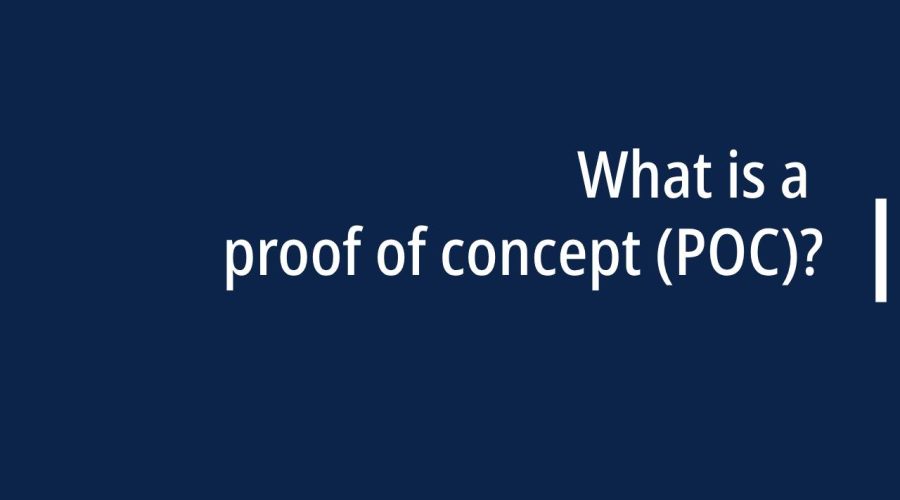In a world driven by innovation and technology, the process of developing new ideas, products, and solutions is often a complex and uncertain journey. This is where a Proof of Concept (POC) comes into play. In this extensive guide, we will delve into the concept of POCs, their significance, the various domains they are employed in, and how they serve as a pivotal tool for innovation and decision-making.
Defining a Proof of Concept (POC)
A Proof of Concept, often abbreviated as POC, is a preliminary demonstration or a small-scale project aimed at validating the feasibility, functionality, and potential of a novel concept, idea, technology, or methodology. It is a strategic and exploratory step taken before committing substantial resources to a full-scale project or implementation.
Key Characteristics of a POC
POCs share some distinctive characteristics:
- Limited Scope: POCs are designed with a narrow scope, focusing on specific aspects or features of the concept under examination. They do not attempt to encompass the full breadth of the idea.
- Resource Efficiency: POCs are cost-effective endeavors, employing the minimum resources required to prove the concept’s viability.
- Quick Execution: Typically, POCs are conducted in a short timeframe to yield swift results and validation.
- Risk Assessment: POCs provide an opportunity to identify potential risks, challenges, and issues that may arise during the full-scale project.
- Learning Opportunity: They offer valuable insights, enabling participants to gain hands-on experience and a deeper understanding of the concept.
- Feasibility Testing: The primary goal is to demonstrate that the concept can operate in a real-world environment.
- Decision Support: Successful POCs provide evidence to justify further investment or development, guiding the decision-making process.
Use Cases and Domains of POCs
POCs are widely used in various domains and industries, serving as a versatile tool for innovation and risk management. Here are some common use cases:
- Technology POC: In the tech world, POCs are frequently used to evaluate new software, hardware, or emerging technologies. Organizations test whether these technologies align with their needs and can be integrated effectively.
- Business POC: Businesses often conduct POCs to validate a new business model, product, or service. This allows them to gauge market interest and potential profitability before a full-scale launch.
- Research POC: In research and academia, POCs serve to validate scientific hypotheses and experimental findings. They offer the opportunity to test theories and gather preliminary data.
- Product POC: Companies may create prototypes or sample products to assess their functionality and usability. POCs are valuable in gathering user feedback and refining product designs.
- Blockchain POC: In the world of blockchain technology, organizations test the application of blockchain in specific use cases to determine its suitability for larger projects.
- IoT POC: The Internet of Things (IoT) relies on POCs to validate the functionality and connectivity of devices and sensors within a specific system.
The Process of Conducting a POC
Executing a POC involves several stages:
- Conceptualization: The process begins with an idea or concept that requires validation. The objectives and success criteria for the POC are defined.
- Planning: A detailed plan is created, outlining the scope, resources, budget, and timeline of the POC.
- Execution: The POC is implemented as per the plan. Data, metrics, and observations are collected throughout the process.
- Evaluation: The collected data and observations are analyzed to determine whether the POC meets the predefined success criteria.
- Reporting and Decision: A report is generated to present the findings and insights from the POC. This report aids in decision-making regarding the concept’s future, which may involve full-scale development or further iterations.
The Significance of POCs
POCs offer several advantages in diverse areas:
- Risk Mitigation: They help identify potential issues and challenges early in the development process, reducing the risk of costly failures in full-scale projects.
- Informed Decision-Making: POCs provide evidence-based data to make informed decisions regarding project viability.
- Resource Efficiency: Resources are allocated efficiently, as the scale of POCs is manageable and cost-effective.
- Innovation Catalyst: POCs encourage innovation by providing a platform to explore and validate new ideas.
- Learning Opportunities: Participants gain practical experience and knowledge that can be applied to future projects.
Challenges and Considerations
While POCs offer valuable insights, they are not without challenges:
- Confirmation Bias: There may be a tendency to skew results in favor of the desired outcome.
- Resource Allocation: Balancing resources between a POC and the full-scale project can be challenging.
- Complexity: In some cases, the complexity of the concept may not be fully revealed in a POC, leading to unexpected challenges during full-scale implementation.
Conclusion
In a rapidly evolving world where innovation and technology are driving forces, a Proof of Concept (POC) is a valuable tool. It allows for the validation of concepts, ideas, and technologies in a controlled, cost-effective, and efficient manner. POCs help organizations and individuals minimize risks, make informed decisions, and foster innovation. As a versatile instrument with applications across numerous domains, POCs are an essential step in the journey of exploration and discovery, ensuring that groundbreaking ideas can become reality.

Gloria Bradford is a renowned expert in the field of encryption, widely recognized for her pioneering work in safeguarding digital information and communication. With a career spanning over two decades, she has played a pivotal role in shaping the landscape of cybersecurity and data protection.
Throughout her illustrious career, Gloria has occupied key roles in both private industry and government agencies. Her expertise has been instrumental in developing state-of-the-art encryption and code signing technologies that have fortified digital fortresses against the relentless tide of cyber threats.
